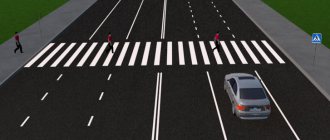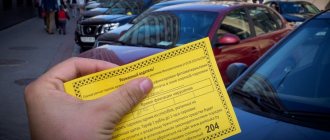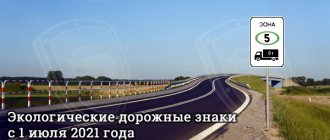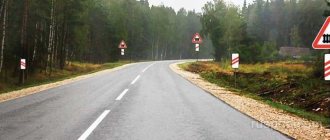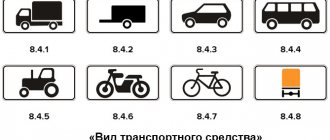Cars are rightful masters on the roads. A pedestrian feels uncomfortable crossing traffic. In the residential area the situation is reversed. Here, the convenience and safety of citizens is more important than the convenience of the motorist.
Dear readers! Our articles talk about typical ways to resolve legal issues, but each case is unique. If you want to find out how to solve your particular problem, please use the online consultant form on the right or call. It's fast and free!
The rules of the State Traffic Inspectorate enshrine the concept of a residential zone. Strict measures are applied to rule violators: deprivation of rights, fines. However, many drivers poorly understand the purpose of the network of local roads within such a zone and use them for through travel.
Residential zone sign and its installation locations
Entry into the territory of a residential zone is determined by a special mandatory sign 5.21.
A diagonally crossed sign (5.22) marks the end of the residential area. The driver who finds himself in the zone of their action is obliged to follow the established traffic order.
Their installation location is:
- residential area in a residential area;
- private sector within the city;
- cottage village;
Such signs are not installed in courtyard areas unless absolutely necessary. This circumstance should not be misleading, since the traffic rules there are the same.
These special signs are installed by local municipalities. At the request of citizens, if these measures are not enough to maintain order, the passage of any transport is prohibited, except for:
- special transport for emergency services;
- personal cars of residents;
- mail, taxi, delivery;
If no one has a clear advantage when entering or leaving
Sometimes cars meet already in the yard, when both end up in the adjacent territory. And in this case, it is impossible to find out who has priority in the movement. And it is necessary to continue the journey, but it is not possible to simply drive past each other due to the narrowness of the space. In this case, who gives way in the yard is determined by the safety conditions for both drivers, the vehicle and common sense.
If one of the cars has the ability to reverse, you should do so so that the second one can pass. The one who can turn to the side and wait there until the opponent leaves the narrow area must also concede. If an SUV and a car meet, the first one can drive onto a high shoulder or move onto a dirt road to allow the second car to pass.
More on AutoLex.Net:
How to figure out what is a detour and what is overtaking?
In short, drivers must be polite, prudent and reasonable. You can agree on who lets someone through using gestures. If the motorist categorically does not want to yield, although he has more favorable conditions for this, the “three D rule” comes into effect. It’s better to let him pass than to conflict. Because during the dispute, the number of cars in the problem area may increase.
Residential zone in traffic rules
A residential zone is an area whose boundaries are indicated by road signs 5.21 and 5.22. Section 17 of the Highway Code requires a number of rules to be followed within this zone. In courtyard areas, these rules are also mandatory.
A courtyard area is a space inside the perimeter formed by residential buildings, or between buildings, on which flower beds, lawns, recreation areas, children's and sports grounds are located.
- The roadway located inside such a zone is primarily intended for pedestrians and cyclists; they have priority here.
- The car must allow them to pass (check-in and check-out is no exception). Unnecessarily, pedestrians (cyclists) do not need to interfere with the movement of cars.
- The speed is limited to 20 km/h.
- Prohibited:
- educational driving;
- through traffic;
- parking for category “C” freight vehicles;
- parking with the engine running;
Correct parking
The Administrative Code and traffic rules in courtyards and residential areas prohibit:
- park trucks weighing more than 3.5 tons (if there is no special parking);
- park:
- in flower beds, lawns or areas with plantings;
- on children's or sports grounds;
- on sidewalks;
Drivers leave their cars under apartment windows to keep an eye on them. There are not enough parking spaces in the courtyards, but this does not change the basic rules:
- the car should not block access roads;
- there is no need to interfere with pedestrians;
- Reverse must be done very carefully; children and pets are not visible in the blind spot;
If these rules are neglected, the following consequences are possible:
- a fire truck or ambulance will not be able to get through in time to help the victims;
- the conflict situation will end in traumatology;
- a criminal case will be initiated regarding the collision with the child;
- you will have to pay a fine;
Is leaving the yard considered an intersection?
Leaving the yard, according to traffic regulations, is not considered an intersection. Here is what is said about this in the “General Provisions” of the legal document:
Crossroads" is a place where roads intersect, join or branch at the same level, limited by imaginary lines connecting, respectively, the opposite, most distant from the center of the intersection, beginnings of curvatures of roadways. Exits from adjacent areas are not considered intersections.
Therefore, the rules for driving through intersections at the exit from the yard do not work.
More on AutoLex.Net:
Maximum speed limit on the highway for different types of transport
Sometimes it is difficult for the driver to understand what exactly is in front of him - an intersection of roads or a section leading from the adjacent territory. To figure it out, you should look at nearby objects. For example, a traffic light is installed only at an intersection, but not at the exit from a residential area. Signs 2.3.1-2.3.7 and plate 8.13 too.
How long does a driver need to comply with restrictions?
Residential or courtyard areas are not intended for the transit of vehicles. You should only enter it if necessary:
- you live in this place;
- came to someone on business;
- you work there;
- intend to buy something;
- it is necessary to disembark a passenger or unload cargo (pick up a passenger, load cargo);
From the moment you entered the coverage area of sign 5.21 or any courtyard area until the moment you left (sign 5.22), you are required to follow the traffic rules established by the traffic police.
What it is
First, let's look at the very concept of a residential area. This is a certain area adjacent to residential private and apartment buildings, which is focused on priority traffic specifically for pedestrians and cyclists. It is this part of the movement participants that is the main one here. Motorists belong to the secondary part.
In simple terms, we are talking about our native yards, where you and I grew up, walked, met with friends, played football, etc. These areas are called residential. Sign 5.21 applies to them. The only problem is that the traffic rules use only one, and rather vague, definition of a residential zone. It is characterized as a specially equipped area in which appropriate or special traffic rules apply, and it is fenced with special signs. But if you rely on traffic rules, then any internal territory belongs to residential areas.
What does this mean? It's simple. Any such territory that corresponds to the descriptions in the traffic regulations is considered a residential area. Moreover, regardless of whether signs are installed there or not. Every driver should remember this.
A visual picture will help you understand what the sign itself looks like. The photo shows that this blue Sign 5.22 is located where the end of the residential zone is located, that is, the effect on speed limits and other limits ends only after the corresponding sign. Or after leaving the yard, if there are no signs at all. This makes it somewhat more difficult for the driver to understand where exactly the special zone begins and ends. Keep it very simple here. When entering the yard, already at the entrance it is considered that the sign is there. Same thing when checking out. This will definitely allow you to avoid fines for various types of illegal actions. If you know something interesting about the rules for installing such signs, be sure to write in the comments.
Next, it’s worth talking about how the restrictions work and what not to do.
Control over driver actions
Very often, a driver, being in a residential area or in a courtyard, thinks that the State Traffic Inspectorate and traffic rules are absent here. If the traffic police inspector is not nearby, then this is not a reason for violating the order established by the rules.
Ways to identify violators:
- various complexes for automatically recording violations:
- stationary - the most advanced (“arrow”, “gyrfalcon”, “auto patrol”, etc.);
- mobile systems - quickly installed in the right place;
- mobile - work in motion mode (for example, parking lots)
- any conscientious citizen has every right to write a complaint to the traffic police and attach to it video recordings and photographs taken with any available device;
- highway patrol;
How to determine the green zone in the yard? | Murmansk
Article 218. Standard tax deductions
1. When determining the size of the tax base in accordance with paragraph 3 of Article 210 of this Code, the taxpayer has the right to receive the following standard tax deductions:
4) the tax deduction for each month of the tax period applies to the parent, spouse of the parent, adoptive parent, who is supporting the child, in the following amounts:
1,400 rubles - for the first child;
1,400 rubles - for the second child;
3,000 rubles - for the third and each subsequent child;
12,000 rubles - for each child if a child under the age of 18 is a disabled child, or a full-time student, graduate student, resident, intern, student under the age of 24, if he is a disabled person of group I or II;
The tax deduction for each month of the tax period applies to the guardian, trustee, adoptive parent, spouse of the adoptive parent who supports the child, in the following amounts:
1,400 rubles - for the first child;
1,400 rubles - for the second child;
3,000 rubles - for the third and each subsequent child;
6,000 rubles - for each child if a child under the age of 18 is a disabled child, or a full-time student, graduate student, resident, intern, student under the age of 24, if he is a disabled person of group I or II.
A tax deduction is made for each child under the age of 18, as well as for each full-time student, graduate student, resident, intern, student, cadet under the age of 24.
The tax deduction is provided in double amount to the only parent (adoptive parent), adoptive parent, guardian, trustee. The provision of the specified tax deduction to the only parent ceases from the month following the month of his marriage.
The tax deduction is provided to parents, the spouse of a parent, adoptive parents, guardians, trustees, adoptive parents, the spouse of an adoptive parent on the basis of their written applications and documents confirming the right to this tax deduction.
At the same time, to individuals whose child (children) is (are) outside the Russian Federation, a tax deduction is provided on the basis of documents certified by the competent authorities of the state in which the child (children) live.
A tax deduction may be provided in double amount to one of the parents (adoptive parents) of their choice based on an application for refusal of one of the parents (adoptive parents) to receive a tax deduction.
The tax deduction is valid until the month in which the taxpayer’s income (with the exception of income from equity participation in the activities of organizations received in the form of dividends by individuals who are tax residents of the Russian Federation), calculated on an accrual basis from the beginning of the tax period (for which the tax rate is provided, established by paragraph 1 of Article 224 of this Code) by the tax agent providing this standard tax deduction, exceeded 350,000 rubles.
Starting from the month in which the specified income exceeded 350,000 rubles, the tax deduction provided for by this subclause is not applied.
The tax base is reduced from the month of birth of the child (children), or from the month in which the adoption took place, guardianship (trusteeship) was established, or from the month of entry into force of the agreement on the transfer of the child (children) to be raised in a family until the end of that year, in which the child (children) has reached the age specified in paragraph eleven of this subclause, or the agreement on the transfer of the child (children) to be raised in a family has expired or been terminated early, or the death of the child (children). A tax deduction is provided for the period of study of the child (children) in an educational institution and (or) educational institution, including academic leave issued in the prescribed manner during the period of study.
Fines for violations in residential areas
An unscrupulous motorist will pay the largest fines in a major city. The fine can range from 1,000 rubles to 5,000 rubles. Legal entities and officials are fined more serious amounts.
Damage to plants in a landscaped area in Moscow costs:
- 4000 rubles for a simple car enthusiast;
- 50,000 rubles to an official;
- 300,000 rubles to a legal entity;
The reason for the fine will be:
- parking in the wrong place (sidewalk, lawn, recreation area, etc.);
- parking with the engine running (more than 5 minutes);
- parking a truck weighing more than 3.5 tons (more than 5 minutes);
- speeding;
In the event of serious violations resulting in an accident or collision with a person:
- fines reach up to 200,000 rubles (for individuals);
- criminal liability (imprisonment from 3 to 7 years);
- deprivation of a driver's license (from 1 to 3 years);
A car driver should always remember that owning a car comes with a burden of responsibility. The cost of the car does not give the driver any advantages over traffic rules, the Code of Administrative Offenses of the Russian Federation, and the Criminal Code of the Russian Federation. Residential areas and courtyard areas require increased attention and caution from the driver.
Didn't find the answer to your question? Find out how to solve exactly your problem - call right now: +7 (Moscow) +7 (812) 309-53-42 (St. Petersburg) It's fast and free!
Free online consultation with a car lawyer
Didn't find the answer to your question? Find out how to solve exactly your problem - call right now: +7 (Moscow) +7 (812) 309-53-42 (St. Petersburg) It's fast and free!
A car blocked the entrance to the yard: what to do
If a car has blocked the entrance to the yard for another car, you should do something to eliminate the problem within the limits of the law:
- First, talk to its owner to remove the vehicle. Sometimes this situation is forced, short-term, and the driver disturbing others leaves a note with his phone number on the windshield of the car. You can rock or gently kick the car to set off the alarm. Then there is a chance that the owner will quickly show up himself.
More on AutoLex.Net:
The last group of symbols from Appendix 1 of the Traffic Regulations are additional information signs: characteristics, features
- If there is no response or it is impossible to find the driver, call the traffic police. You need to explain the situation, give the address and name the registration number of the car blocking the road. The inspector will contact its owner, and it will be easy for the police to find his phone number. If unsuccessful, the traffic police will call a tow truck. The car that has become an obstacle will be removed to a special parking lot. Moreover, its owner will pay for the movement and location of the vehicle there.
If a motorist is blocked from entering the courtyard of the building where he has an apartment, this is illegal, and you need to deal with the homeowners association. It does not have the right to deprive the property owner of the opportunity to enter the territory that is common to all residents of the house. This norm is established by clause 5 of Article 16 of the Law “On the Entry into Force of the Housing Code of the Russian Federation”:
From the moment the land plot is formed and its state cadastral registration is carried out, the land plot on which the apartment building and other real estate objects included in such a building are located passes free of charge into the common shared ownership of the owners of the premises in the apartment building.
And also Article 262 of the Civil Code of the Russian Federation, which states that people have the right to be on land plots that are not closed to public access and to use the objects located on them.
The Supreme Court of the Russian Federation considered a similar case, and the decision was made in favor of the one who was denied entry into the yard by the general meeting. If we are talking about the car of a person who does not live in an apartment building, if there is a legally installed barrier, they have the right to prohibit him from being in this adjacent territory.
There may be a “Do Not Occupy Entry” sign near the entrance to the area, and this requirement must be obeyed. The same designation is attached to gates that close the courtyards of private houses, and there it has the right to exist.
Watch this video about what to do if a car blocks the passage to the yard:
What does the residential zone sign mean: action, restrictions, fine for violation
Hi all! Drivers who have been trained in driving schools probably know about the Residential Zone sign. Although in practice, not everyone has encountered it, since in Russia it is used quite rarely. Nevertheless, it is spelled out in the traffic rules, and therefore exists.
Roads are divided into different zones, each of which may have its own special rules. The type and rules of movement (movement) along them depend on the specific purpose, location and other nuances.
Today we are talking about clause 5.21 in the traffic rules and what this sign means, what it prohibits and what restrictions it provides for drivers. I think many will be interested in reading the material. For some, it is simply important to know what the fine is for violating this rule.
Residential zone road sign - what does it mean and where is it installed?
Cars are rightful masters on the roads. A pedestrian feels uncomfortable crossing traffic. In the residential area the situation is reversed. Here, the convenience and safety of citizens is more important than the convenience of the motorist.
Dear readers! Our articles talk about typical ways to resolve legal issues, but each case is unique.
If you want to find out how to solve your particular problem, please use the online consultant form on the right or call. It's fast and free!
The rules of the State Traffic Inspectorate enshrine the concept of a residential zone. Strict measures are applied to rule violators: deprivation of rights, fines. However, many drivers poorly understand the purpose of the network of local roads within such a zone and use them for through travel.


